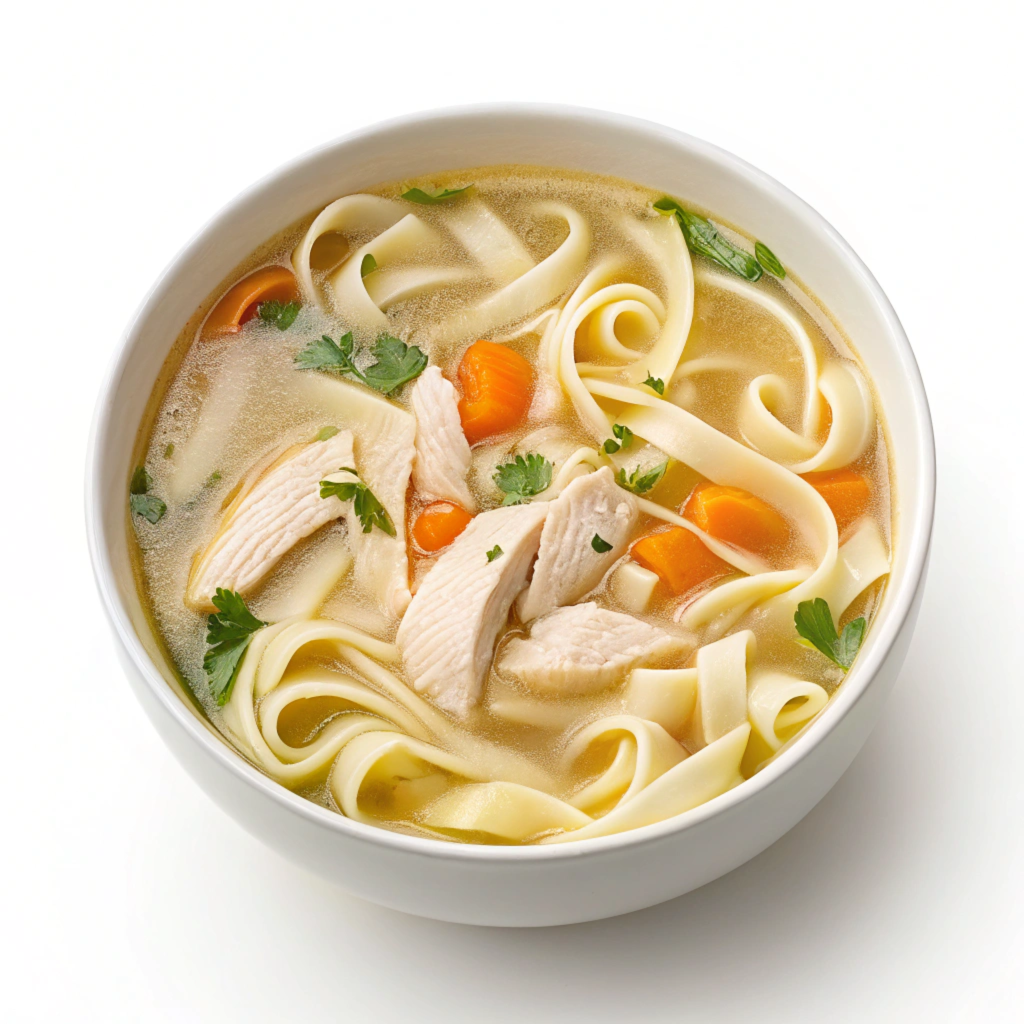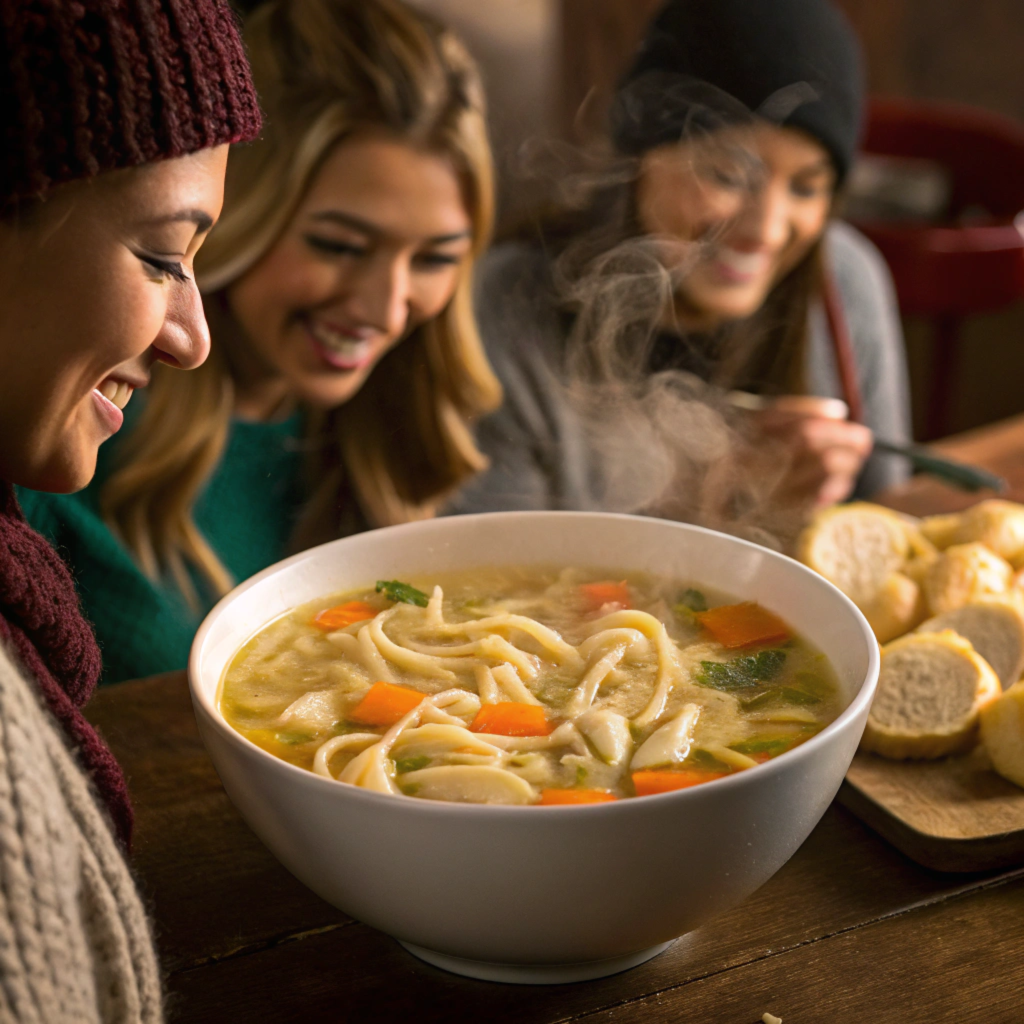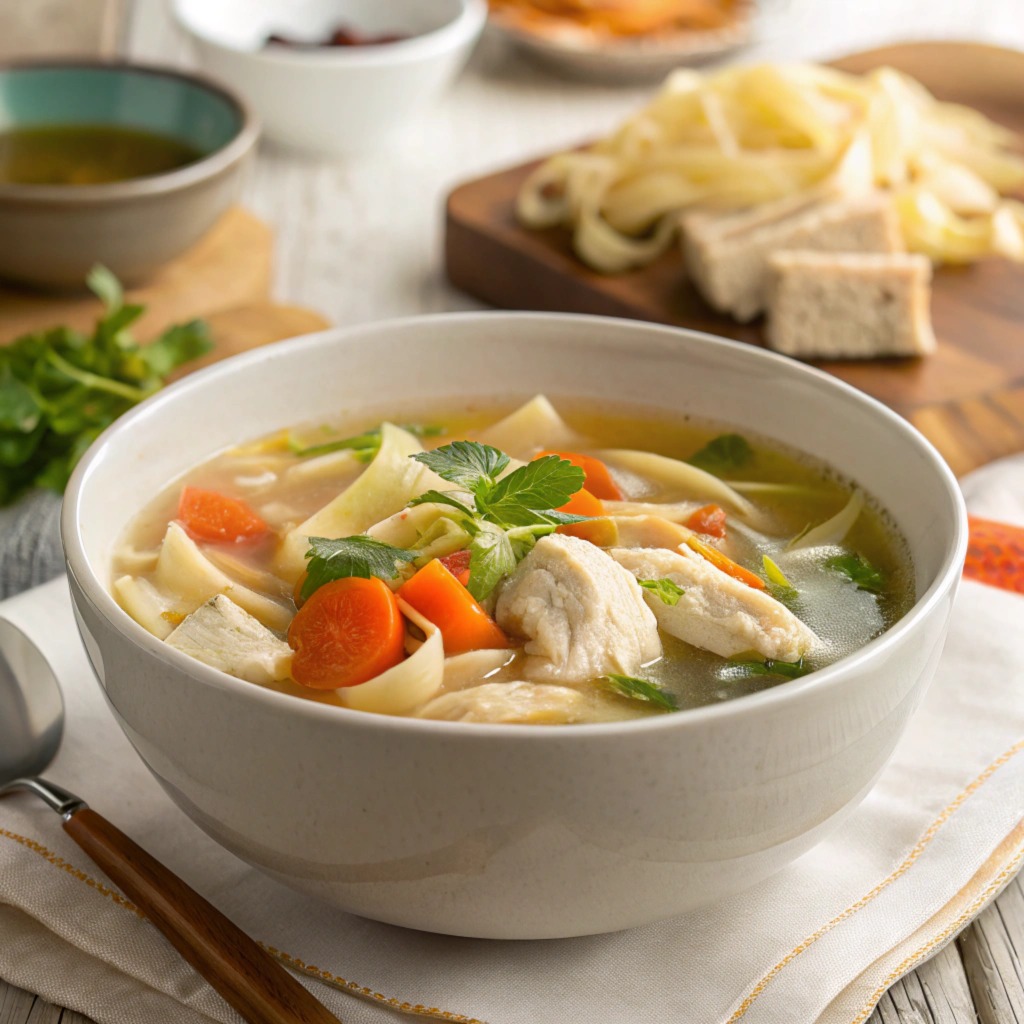
Adding noodles to chicken soup creates a satisfying, hearty meal. Many home cooks wonder if it’s possible to put uncooked noodles directly into the soup instead of cooking them separately. The short answer is yes, but there are essential steps and tips to ensure the noodles cook perfectly without turning mushy. In this guide, we’ll explore how to add uncooked noodles to chicken soup while keeping the texture and flavor just right.
Why Noodles Are Essential in Chicken Soup
Noodles are a key ingredient in chicken soup because they add texture, heartiness, and a source of carbohydrates. They absorb the soup’s savory broth, enhancing the overall flavor. A well-balanced chicken soup typically includes tender chicken, aromatic vegetables, flavorful broth, and perfectly cooked noodles. The combination creates a filling and nutritious meal that’s both comforting and nourishing.
Whether you prefer traditional egg noodles, spaghetti, or whole-wheat pasta, adding uncooked noodles directly to the soup can save time and minimize cleanup. However, choosing the right type of noodle and following a few essential tips can make all the difference.
Traditional vs. Shortcut Methods for Adding Noodles
When making chicken soup, home cooks can choose between two methods for adding noodles: cooking them separately or directly in the soup.
- Traditional Method: Cooking noodles separately prevents the broth from becoming too starchy or thick. This method is ideal if you plan to store leftovers since noodles won’t soak up the broth during storage.
- Shortcut Method: Adding uncooked noodles directly to the soup is quicker and reduces the number of dishes. This method works well if you plan to serve the soup immediately after cooking.
Both methods have advantages, but if you want convenience without sacrificing quality, cooking noodles in the soup can be the perfect option.
Convenience of Cooking Noodles Directly in Soup
Cooking uncooked noodles directly in chicken soup is a convenient way to streamline the cooking process. It eliminates the need for a separate pot, reducing cleanup time. The noodles also absorb the soup’s delicious flavors, enhancing the overall taste.
However, it’s important to monitor cooking times carefully. Adding noodles too early can cause them to overcook and become mushy. To avoid this, add the noodles toward the end of the cooking process—about 10-12 minutes before serving. Stir occasionally to prevent them from sticking to the bottom of the pot.
Tips for Perfectly Cooked Noodles in Soup
- Choose the Right Noodles: Use sturdy noodles like egg noodles, rotini, or whole-wheat pasta. Avoid delicate varieties that break down quickly.
- Add Noodles at the Right Time: Wait until the soup is nearly done before adding noodles to prevent overcooking.
- Check for Doneness: Taste-test noodles for doneness before serving. They should be tender but still slightly firm.
Adding Uncooked Noodles: Pros and Cons
When making chicken soup, deciding whether to add uncooked noodles directly into the broth can impact the soup’s texture, flavor, and overall experience. While this method offers convenience, it also has some drawbacks. Let’s break down the advantages and challenges of cooking noodles directly in chicken soup to help you decide the best approach for your next meal.
Pros of Adding Uncooked Noodles
Adding uncooked noodles directly to chicken soup is a popular choice because of its simplicity and time-saving benefits. Here’s why it works:
- Fewer Dishes to Clean: Since there’s no need for a separate pot, you’ll have fewer dishes to wash, making cleanup faster and easier.
- Enhanced Flavor Absorption: Cooking noodles in the soup allows them to absorb the savory broth, making each bite rich with chicken and vegetable flavors.
- One-Pot Meal Convenience: Combining all ingredients in a single pot simplifies meal preparation, making it ideal for busy weeknights or large family meals.
- Controlled Texture: If monitored carefully, noodles can cook to the desired texture without becoming mushy. This method works well with egg noodles, rotini, or even whole-wheat pasta.
Cons of Adding Uncooked Noodles
While convenient, there are some potential downsides to cooking noodles directly in chicken soup:
- Risk of Overcooking: If noodles are added too early or the soup simmers for too long, they can become overly soft or fall apart.
- Thickened Broth: As noodles cook, they release starch, which can make the soup broth thicker and cloudier than expected.
- Limited Storage Life: Noodles left in the soup during storage can absorb too much broth, leading to a mushy texture upon reheating. For best results, consider storing the soup and noodles separately if planning for leftovers.
- Salt Absorption: Noodles may absorb salt from the broth, altering the overall seasoning. Taste-test the soup before serving to ensure the flavors remain balanced.
Best Types of Noodles for Chicken Soup
Choosing the right noodles can prevent many of the challenges mentioned above. Consider these pasta options for the best results:
- Egg Noodles: A classic choice for chicken soup, offering a soft yet sturdy texture.
- Rotini or Fusilli: Their spiral shape holds onto broth and seasonings.
- Whole-Wheat Pasta: A healthier alternative that adds fiber and keeps its structure well.
- Spaghetti or Angel Hair: Break into smaller pieces for a more traditional chicken noodle soup.
For those with dietary restrictions, gluten-free or low-carb noodle alternatives like zucchini noodles (zoodles) or shirataki noodles are excellent substitutions.
How to Add Uncooked Noodles to Chicken Soup
Adding uncooked noodles to chicken soup can be an easy way to create a complete, one-pot meal. However, timing, preparation, and technique are crucial to achieving the best results. Follow these steps to ensure your noodles cook perfectly without becoming mushy or absorbing too much broth.
Step 1: Prepare the Soup Base
The foundation of any great chicken soup starts with a flavorful broth. Here’s how to prepare it:
- Cook the Chicken: Begin by cooking the chicken in a large soup pot with olive oil or butter. Brown the meat for added flavor.
- Sauté the Vegetables: Add diced onions, carrots, and celery to the pot. Sauté until softened, releasing their natural sweetness.
- Add the Broth: Pour in chicken broth or stock, ensuring there’s enough liquid to accommodate the noodles later. For deeper flavor, use homemade broth or bone broth.
- Season Generously: Add garlic, thyme, bay leaves, salt, and pepper. Simmer for at least 20-30 minutes to let the flavors develop.
Step 2: Add Noodles at the Right Time
The most critical step is knowing when to add the uncooked noodles:
- Check the Soup’s Progress: Ensure the chicken is fully cooked and the vegetables are tender.
- Add the Noodles: Pour uncooked noodles into the simmering soup about 10-12 minutes before the soup is finished. Stir gently to prevent sticking.
- Monitor the Cooking Time: Depending on the noodle type, cook until just tender. Egg noodles usually take 8-10 minutes, while pasta like rotini may take 10-12 minutes.
- Stir Occasionally: Stir every few minutes to ensure even cooking and prevent noodles from clumping together.

Step 3: Check for Doneness
Properly cooked noodles should be tender but not overly soft. Here’s how to confirm readiness:
- Taste-Test the Noodles: Sample a piece to ensure it’s cooked to your preferred texture—al dente for a firmer bite or fully tender for a softer soup.
- Turn Off the Heat: Remove the pot from the heat as soon as the noodles are done. Allow the soup to rest for about 5 minutes before serving to let flavors meld.
- Garnish and Serve: Add fresh herbs like parsley, dill, or a squeeze of lemon for a burst of brightness. Serve hot with crusty bread or a light salad.
Pro Tips for Success
- Cook Noodles Separately for Leftovers: If you expect leftovers, consider cooking noodles separately and adding them to each bowl before serving. This prevents sogginess.
- Use the Right Pasta Type: Egg noodles, rotini, and spaghetti work well. Avoid delicate pasta like angel hair, which can break apart easily.
- Balance Broth and Pasta: Add extra broth if the soup thickens too much after the noodles are added.
Tips for Perfect Noodles in Chicken Soup
Achieving the perfect noodles in chicken soup requires thoughtful preparation and cooking techniques. Whether you prefer soft egg noodles or firm pasta, following the right tips can prevent sogginess and ensure a delicious meal every time.
Cooking Tips for Best Texture
- Choose the Right Noodles: Use egg noodles, rotini, or whole-wheat pasta for soups, as they hold up well during cooking. Avoid delicate options like rice noodles unless cooking separately.
- Cook Noodles in the Soup Carefully: Add noodles when the soup is almost done, about 8-12 minutes before serving. This timing keeps them from becoming mushy.
- Avoid Overcooking: Turn off the heat when the noodles are al dente. They will continue softening from the soup’s residual heat.
- Stir Occasionally: Stir noodles gently to keep them from sticking together but avoid over-stirring, which can break them apart.
Storage and Leftovers
- Separate Storage: If making extra soup, store noodles separately from the broth. This prevents them from soaking up liquid and becoming too soft.
- Use Airtight Containers: Keep both the soup and noodles in airtight containers in the refrigerator for up to 4 days.
- Reheat Properly: Reheat soup on the stove over low heat. Add noodles just before serving to warm them through without overcooking.
- Freezing Tip: Avoid freezing soup with noodles, as they may lose texture upon thawing. Instead, freeze the soup base and cook fresh noodles when ready to serve.
Customizations and Add-Ons
- Fresh Herbs for Extra Flavor: Add chopped parsley, dill, or cilantro just before serving for a bright, fresh taste.
- Lemon Zest or Juice: A squeeze of lemon enhances the soup’s flavor, adding freshness and balancing the richness of the broth.
- Parmesan or Cheese Garnish: Sprinkle grated Parmesan or Pecorino Romano for a savory finish.
- Vegetable Boost: Add spinach, kale, or green beans for added nutrients and variety.
Pro Noodle Tips for Special Occasions
- Try Homemade Noodles: Make homemade pasta for a special touch if time allows. Fresh noodles cook faster and taste incredible.
- Experiment with Global Flavors: Try Asian-inspired noodles like udon or ramen for a fusion twist on traditional chicken soup.
- Use Gluten-Free Options: Opt for gluten-free noodles made from chickpeas, lentils, or rice if you follow a gluten-free diet.
Common Questions About Noodles in Chicken Soup
Adding noodles to chicken soup raises several common questions for home cooks. From choosing the right type of noodles to understanding how they affect the soup’s texture, these FAQs cover everything you need to know to create the perfect bowl.
Can I Use Instant Noodles?
Yes, instant noodles can be used in chicken soup. They cook quickly, making them ideal for a fast meal. However, keep these tips in mind:
- Skip the Seasoning Packet: If using packaged instant noodles, avoid the seasoning packet to maintain the soup’s original flavor.
- Add at the Right Time: Add instant noodles just 3-4 minutes before serving to prevent overcooking.
Do Noodles Thicken Soup?
Yes, noodles can thicken chicken soup. When cooked directly in the broth, noodles release starch, which makes the soup thicker and creamier.
- Managing Thickness: If you prefer a thinner soup, add extra broth or water as needed.
- Choosing Low-Starch Noodles: Use whole-wheat or gluten-free noodles for less starch release.

Can I Freeze Chicken Soup with Noodles?
Freezing chicken soup with noodles is possible but not recommended. Noodles tend to become mushy when thawed. Instead:
- Freeze the Soup Base Only: Make and freeze the chicken soup without the noodles.
- Add Fresh Noodles When Reheating: Cook fresh noodles separately and combine them with the reheated soup for the best texture.
What Noodles Are Best for Chicken Soup?
Several types of noodles work well in chicken soup:
- Egg Noodles: Traditional and hearty, these noodles absorb the broth without falling apart.
- Spaghetti or Linguine: Break these into smaller pieces for an easy, budget-friendly option.
- Gluten-Free Pasta: Use chickpea, rice, or lentil pasta if you need gluten-free alternatives.
How Do I Prevent Noodles from Becoming Soggy?
To prevent soggy noodles:
- Add Noodles at the End: Cook noodles in the last 8-10 minutes of simmering.
- Cook Separately: Boil noodles in a separate pot and add them to the soup just before serving.
- Avoid Overcooking: Turn off the heat when noodles are slightly firm; they will finish cooking in the hot soup.
How Long Should Noodles Cook in Soup?
Noodles typically take 8-12 minutes to cook in chicken soup, depending on their type.
- Check Package Instructions: Follow the cooking times listed on the noodle package.
- Taste for Doneness: Test noodles by tasting them 2 minutes before the suggested time to avoid overcooking.